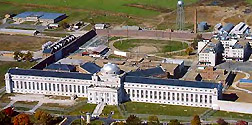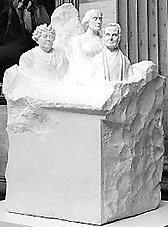|
An Inventory of Papers in Syracuse University Libraries© History
The papers of Peter Pelham (b. Dec. 18, 1785) form the earliest body of records. As a U.S. Army officer in the War of 1812, he was wounded and captured by the British, then returned to American lines in exchange for British prisoners. After the war Pelham was promoted to captain and stationed in the Florida Territory as a sub-agent for Indian affairs.
Among his correspondents between 1812 and 1826 were Secretary of War John C. Calhoun, Col. Henry Atkinson, who was his uncle, Col. Henry Leavenworth, and Col. Josiah Snelling. . . . Pelham married Martha Coffin, the sister of Lucretia Coffin Mott and the daughter of Nantucket and Philadelphia Quakers. They had one child, Marianna. Capt. Pelham . . . died on July 10, 1826 . . . . Martha Coffin Pelham remarried in 1829. Her second husband was David Wright (b. Mar. 18, 1806), who moved from Pennsylvania as a young man and practiced law in Auburn, N.Y. There were six children from the second marriage, among them
The Wrights and the Coffins, and their relatives in the Mott family, were active in the movements for women's rights and abolition. Martha Coffin Wright died in 1875 and David Wright in 1897. Their eldest daughter, Eliza, had married David Munson Osborne in 1851. Osborne (b. Dec. 15, 1822) was the son of John Hall and Caroline Bulkley 0sborne of Rye, N.Y. When John Osborne died in 1839, David was left to support his mother, brothers and sisters. D. M. Osborne began his business career as a clerk in a New York City hardware store . . . [and] met James Watrous, an Auburn storekeeper who invited Osborne to become a junior partner . . . When James Watrous retired, Osborne assumed control of the store but abandoned it soon afterwards to manufacture straw cutters and corn shellers. After the business failed, Osborne moved to employment in Buffalo. As general superintendent of the Buffalo Agricultural Works, he met William Kirby, a mechanic who possessed untried patents for agricultural machinery. Soon Osborne was back in Auburn with Kirby. Their new company turned out 200 combination mowers and reapers in 1857 . . . . By 1866, having won two blue ribbons in the national trials, D.M. Osborne & Co. was solidly established . . . . Eventually there were offices and warehouses in Philadelphia, Chicago, St. Louis, San Francisco, Hamburg, Paris, Odessa, Sydney and Buenos Aires. As a Republican, David Munson Osborne took an active part in local politics, being elected alderman from 1871 to 1874 and mayor from 1879 to 1880. After his death in 1886, his wife continued to interest herself in the arts and education in Auburn. She died in 1911. The Osbornes had four children:
All these people wrote scores of letters around the turn of the century, and the correspondence of Thomas Mott Osborne amounts to thousands of items between 1880 and 1926. |
| The Osborne Family Inventory text 1971 by Syracuse University Libraries |


